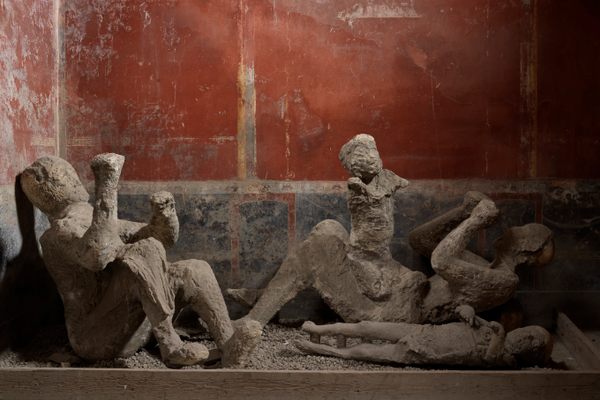When Ancient Romans Had Their Clothes Stolen, They Responded With Curse Tablets
The gods shall punish toga thieves.

A Roman curse tablet from Bath. (Photo: Mike Peel/CC BY-SA 4.0)

Famed for its healing waters and once home to Jane Austen, the southwestern British city of Bath also boasts a history rich in Roman magic. In antiquity, individuals came in droves to soak in Bath’s hot springs—and to use “curse tablets” to get revenge on people who stole their clothes.
In 1979, when archaeologists first excavated the Roman-era King’s Bath, the murky waters of what was once a sacred spring yielded hundreds of tiny objects. These votives included about 130 rolled up pieces of metal dating from the first few centuries A.D. These were curse tablets, common across the Greco-Roman world from the fifth century B.C. to late antiquity.
The standard definition of the curse tablet, as put forth by David R. Jordan, is: “inscribed pieces of lead, usually in the form of small, thin sheets, intended to influence, by supernatural means, the actions or welfare of persons or animals against their will.”
Although Julius Caesar first invaded Britain in the 50s B.C., he didn’t press his conquest. A century later, doddering Claudius, he of I, Claudius fame, brought Britain into the imperial fold. Over the next several centuries, an influx of new people brought new goods, ideas, and gods.
In ancient Bath, curse tablets were often addressed to Sulis Minerva: a conflation of the goddess Sulis, who was said to guard the spring, and her Roman counterpart, Minerva. The Romans employed such religious hybridization, called interpretatio Romana, translating deities of the people they conquered into their own pantheon.

An ancient Bath bath. (Photo: Grand Parc - Bordeaux, France/CC BY 2.0)
Christopher Faraone of the University of Chicago, who has written extensively on ancient magic, delineates two categories of curse tablets. The first is binding curses, or defixiones, “primarily used to restrain competitors” in love, sport, and law. The second category, “prayers for justice,” included the Bath tablets, which mostly discussed theft. Here, tablet writers essentially appointed deities as divine bounty hunters, tasking them with tracking down the thieves and administering justice.
Curses from many urban centers addressed “mundane daily problems,” says Andrew Mark Henry, a Ph.D. candidate at Boston University studying late antique religion. “Theft would have been a relatively common occurrence, as it is today, and curse tablets would have served as a readily available strategy for someone to cope with theft in lieu of a robust police force.”
If the victim of theft knew the name of the person who had wronged them or of potential suspects, they would include it on the tablet. “I have given to the goddess Sulis the six silver coins which I have lost,” reads one Bath tablet. “It is for the goddess to exact them from the names written below: Senicianus and Saturninus and Anniola.”

One of the curse tablets found at Bath. (Photo: Mike Peel/CC BY-SA 4.0)
Next, says Faraone, devotees would demand “on the grounds that justice be performed, that the god or goddess make this person sick until they come to the sanctuary and return the material.” One tablet reads, “Solinus to the goddess Sulis Minerva. I give to your divinity and majesty my bathing tunic and cloak. Do not allow sleep or health to him …who has done me wrong, whether man or woman, whether slave or free, unless he reveals himself and brings those goods to your temple.”
The Bath tablets may have been displayed publicly and read aloud to the public before being dropped in the sacred pool. Faraone compared the Bath texts to those of the Sanctuary of Demeter at Cnidus, Asia Minor; those texts were set up publicly so that worshippers, who would hear them being read aloud, “might provide missing information about unsolved crimes and … might also bring social pressure to bear upon the alleged criminals … and thereby resolve the conflict.”

Modern Bath, built atop the ancient springs. (Photo: Diliff, CC-BY 2.5)
A cheap way of seeking justice, curse tablets were accessible to many. “Most people estimate ancient literacy around the 10-15 percent range, and curse tablets were definitely written by everyone in that group,” says Katherine McDonald, a research fellow in classics at Gonville and Caius College at Cambridge University. This would have included slaves, craftsmen, and soldiers. But the tablets are “far from showing us the whole range of people in Roman society.”
Perhaps the visitors at the baths were poor—their tablets often complained about the theft of small items—so they couldn’t afford to hire guards or buy slaves to protect their belongings while they bathed. Or maybe the survival of so many tablets discussing theft was due to the durability of the materials on which they written.
The relative ease of making a tablet allowed many people to curse, says Stuart McKie, Ph.D. candidate at Open University studying curse tablets. “All you really needed was a piece of lead and a vague understanding of what to do.”















Follow us on Twitter to get the latest on the world's hidden wonders.
Like us on Facebook to get the latest on the world's hidden wonders.
Follow us on Twitter Like us on Facebook